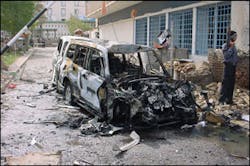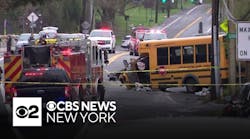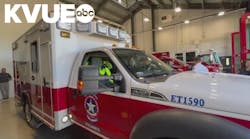In July 2005, the U.S. Department of Homeland Security (DHS) distributed an Information Bulletin to all state, federal and local law enforcement agencies in the U.S. that addressed the threat of vehicle-borne improvised explosive devices (VBIEDs). The bulletin states that there is no specific or credible intelligence indicating that terrorist organizations intend to use VBIEDs against U.S homeland targets. However, the growing use and frequency of lethal VBIED incidents overseas is cause for continuing concern.
It is also important to note that in the al Qaeda training manual, Military Studies in the Jihad against the Tyrants, bombings are described as one of the primary means for al Qaeda to accomplish its missions. Al Qaeda has extensive experience in conducting VBIED attacks using static vehicles and suicide operations. Several other groups around the world such as the Real IRA (Europe), Basque Homeland Freedom and ETA (Europe) and the Revolutionary Armed Forces of Colombia, or FARC (Colombia), have used VBIEDs successfully.
What does all this information mean for public-safety agencies and how should we address it?
If your agency receives a report about a possible "car bomb" incident or suspicious vehicle, what is the safest way to respond? How would your agency respond to this type of incident? These are just a few of the issues that each agency must consider when planning for a response to a car bomb. Every week on the nightly news, we see the scenes of chaos and destruction caused by car bombings around the globe. I have taken some lessons learned in the Middle East and other locations and applied them to first responder training points. This article outlines steps that fire and EMS providers can take to prepare for the growing threat of a potential VBIED bombing.
VBIED Overview
One way to prepare for the future is to review past incidents. Two notable VBIED events that have occurred in the U.S. were the first World Trade Center bombing in 1993 and the 1995 Oklahoma City bombing in 1995. In each case, a rental truck was used to deliver the device to the scene and the bomb was assembled from commercially available materials.
VBIEDs are one of the largest hazards in Iraq and Afghanistan that Coalition Forces face. In Iraq, dozens of "car bombings" occur each month. It is important to take the valuable and sometimes fatal lessons learned in Iraq and apply them to training and planning for terrorist events at home. VBIEDs have been proven a favorite and effective mode for terrorists to successfully penetrate a target and create injuries and chaos. Enemy forces are now using VBIEDs as one of the preferred methods of attack on Coalition forces, as this allows the attacker a standoff capability to initiate an attack, employ large amounts of explosives, cause maximum loss of life and then quickly escape the area.
In Iraq, most VBIEDs are unique because the builders must improvise with the vehicles and materials at hand. VBIEDs are also usually designed to defeat a specific target or type of target, so they will generally become difficult to detect and protect against as they become more sophisticated. They have been employed against U.S. forces by several means, including:
- Using locally purchased, wireless, battery-powered doorbell devices, car alarms, cordless phones or cell phones to remotely initiate VBIEDs and other IEDs
- Using speaker and similar type of locally purchased wiring to connect the explosives
- Using decoy devices (bait devices or vehicles) out in the open to slow or stop U.S. forces in the "kill zones"
- Using suicide bombers to guide a vehicle into a target (for additional information on suicide bombers, see "Fire-EMS Response to Suicide Bombing Events," Firehouse, September 2005)
Types of Attacks
VBIED attacks can typically be classified in four groups.
1. Single, stationary VBIED attack - These vehicles can be placed on the side of a major highway or in a busy intersection, crowded market or other choke point with a flat tire, hood up, etc. The device will be detonated by timer or from a bomber watching from a distant location, as in the first World Trade Center bombing and the Oklahoma City bombing.2. Decoy vehicle, speeding VBIED attack - One vehicle approaches a location such as a check point, convoy or parking area to distract security forces as the speeding VBIED attacks the target.
3. Two suicide VBIEDs attack - During this type of large, coordinated attack, the first vehicle will get as close as possible to the target and detonate creating a "hole" in the security perimeter allowing the second vehicle to quickly move through the "hole" into the area blowing up even closer to the target. Small-arms fire (SAF) and rocket-propelled grenades (RPGs) may be used to neutralize security forces and help the suicide bombers get as close as possible to their target.
4. Trolling VBIED attack - A suicide bomber drives the VBIED around town looking for targets of opportunity. Once the bomber spots the target, he approaches and detonates the device. This type of attack has been described as the "poor man's smart bomb," as the homicide bomber can avoid security, shift targets, delay an attack or postpone until a later time.
One current tactic used by insurgents in Iraq is to move VBIEDs in a pack of three cars. Car 1 is the spotter vehicle, car 2 carries the device and car 3 has a photographer to record the attack for later use on the insurgent websites and for recruiting. Insurgents have also been recently taping the hands of the suicide bomber to the steering wheel of the vehicle. This prevents the driver from releasing the steering wheel even if injured during the attack.
U.S. armed forces and security contractor teams in Iraq and Afghanistan use several methods to deal with this hazard when on the road. All personnel in a vehicle remain constantly alert and try to avoid these suspicious vehicles and vehicle choke points, stay in constant communication with other vehicles in the patrol or convoy, vary routes and times, switch lanes at random and use many other means not listed here due to security concerns to help reduce the risk from these devices.
The methods of attack listed above are currently described in insurgent training and recruitment videos, al Qaeda manuals and several extremists' websites, making them easily available to anyone with an interest. Any of the means described above could be used in the U.S. during a terrorist attack.
When responding to a confirmed or suspected VBIED incident, get all the dispatch information you can, look at the routes into the event, survey the scene for a moment, keep an escape route to get out of the scene quickly, look at the area where you are parking and staging, and be aware of secondary devices.
Pre-Detonation Response
Pre-detonation response occurs BEFORE an explosion occurs. If there's a report of a possible VBIED, little time will be available for police intervention if the vehicle is being driven by a possible homicide bomber, especially when the vehicle is moving toward their target or the "handler" is ready to initiate the VBIED. The following are important considerations to prepare for response to bombings:
- 911 call takers and dispatchers must obtain as much information as possible (every effort should be made to keep the callers on the line during the response and extreme specificity should be obtained from the caller about the direct knowledge they possess as to why the vehicle is suspected of being a possible VBIED)
- A unified command post and fire-EMS staging areas should quickly be established well outside the potential hazard zone
- A fire-EMS task force or strike force should be established and available to respond out of staging areas if time and circumstances allow
- Rapid communications will prove vital (standard guidelines that prohibit the use of cell phones and radios aren't applicable during these events-unless law enforcement officials suspect a VBIED will be triggered by emergency service radios) because there will be an overriding need for a rapid, coordinated response
- Obtain all the information possible on why the vehicle is suspected of being a VBIED
- Observe the vehicle when possible from a good distance away, behind hard cover using spotting equipment such as binoculars or scopes
- Bomb squad personnel or robots should be the first to approach a VBIED or suspected VBIED
- Responders should be prepared to establish flexible evacuation and containment areas
- If an explosion occurs, there must be a controlled response into the hazard area to prevent unnecessary injuries or deaths due to a secondary device
If the vehicle or vehicle driver is neutralized and there's no explosion, don't approach or render aid to the suspect until cleared to do so by law enforcement officials. The suspect may be injured, but still free to detonate the device, or the VBIED could still be "hot." Bomb squad personnel or robots should be the first to approach a VBIED or suspected VBIED.
Post-Detonation Response
Post-detonation response takes place AFTER an explosion has occurred. It's important to note that a VBIED bombing has the overwhelming potential to produce a large number of victims and fatalities:
- 911 call takers and dispatchers must get as much information as possible
- First responders must proceed with extreme caution for their own safety as well as the safety of the public (be continuously alert for the possible detonation of secondary devices)
- Standard guidelines that prohibit the use of cell phones and radios do not apply
- A unified command post and vehicle staging areas should quickly be established outside the hazard area
- The incident management system (IMS) should be initiated as soon as possible
- Fire and EMS supervisors must conduct and report a rapid scene size-up or "windshield survey"
- Implement local mass-casualty and mass-fatality procedures, especially with notifications of local hospitals
- Injured victims should be extracted from the hazard area and care rendered in a secure location some distance from the event (use a triage system to sort and transport patients on a priority basis; triage must be conducted outside the hazard area)
- Immediately monitor for other hazards, such as chemical agents, gases, bio-hazard, radioactive materials or secondary devices
- If there is a suspected bomber, do not approach the suspect or the suspect's remains; undetonated or partially detonated explosives or secondary devices may be present
- A bomb squad or robot must first approach a bomber or suspected bomber, no matter how long the wait
- Be aware of the possibility of secondary devices and snipers or active shooters in the area
- If vehicle or structure fires are involved, conduct a rapid knockdown while preserving evidence as much as possible
- Establish as large a crime- scene perimeter as soon possible, and preserve evidence by isolating it and notifying law enforcement whenever it's found
- Leave emergency vehicles that were inside the primary blast or crime scene in place until the bomb squad can determine they are safe to move and moving them will not destroy key evidence
- Be prepared for an intensive media response
- Notify or request appropriate local, state and federal resources
- Be prepared for an extensive, multi-day crime-scene investigation
Scenes involving VBIEDs will be fluid, dynamic situations. Responders have been killed at these types of events. Command officers must be prepared to relocate or evacuate sectors or the command post at any moment.
Response Considerations
If a first responder (fire, EMS or law enforcement) comes across a suspicious vehicle or device during routine activities, immediately inform all personnel and leave the area. Do not use your radio for this activity until you are some distance away from the vehicle. If you find yourself next to a possible VBIED, take these steps:
- Call out to other personnel that you have found something (wires, devices, containers, etc.)
- Do not touch or move anything
- Do not open or close the doors, hood or trunk
- If inside the vehicle exit the same way you entered
- Move yourself, other responders and the public out of the area as quickly as possible
At this point in the incident, time could be essential, as the device could be set on a timer or detonated remotely by the handler watching the incident. If you discover an exploded or unexploded VBIED, you have discovered a serious crime scene and it must be treated as such.
Scene Management
Several important decisions will need to be made at the scene. The IMS is one of the best tools for agencies to use to deal with these types of events.
Upon being notified of an actual or suspected VBIED the incident commander should implement the "5 Cs Rule", confirm there is a device, clear the area, cordon off the location, control all entry and exit points, and check the immediate area for secondary devices.
The response to a VBIED is similar to a hazmat response. Use your "zones of control":
- Hot zone - Where the device is located
- Warm zone - Where the perimeter will be established
- Cold zone - Location of a unified command post and staging
All appropriate agencies (fire, EMS, law enforcement, bomb squad, emergency management office and others as needed) should be notified as soon as possible.
According to the U.S Bureau of Alcohol, Tobacco, Firearms and Explosives (ATF), the minimum safe evacuation distance for a small compact sedan loaded with up to 500 pounds of explosives is 1,500 feet. Larger vehicles can require up to 6,000 or 7,000 feet for the minimum safe evacuation distance. Dozens or even hundreds of people may be within that range and they will need to be quickly and safely evacuated away from the "hot zone."
August Vernon is the assistant coordinator with the Winston-Salem/Forsyth County, NC, Office of Emergency Management. He recently returned from a year in Iraq as a security contractor. Vernon is also an adjunct instructor for the U.S. Department of Homeland Security's OPSEC for Public Safety program. He has been involved in emergency management since 2000 and a member of the fire service since 1990. Vernon served in the U.S. Army as an NBC (Nuclear, Biological, and Chemical) Operations Specialist. Vernon can be reached reference for questions or comments at [email protected].






